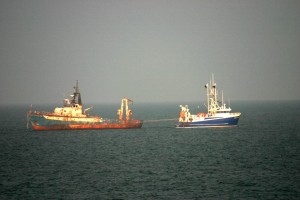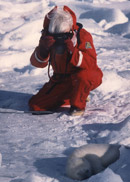By Nancy Willis
SOURIS – The gray hulk of the Nadine looms out of the mist in Souris harbour, tugging gently on the lines that hold the aging trawler to her berth.
 Rust streaks her sides and an eerie quiet swirls around her superstructure where the voices of fishermen are silent. The bridge is dark inside, empty, a story untold.
Rust streaks her sides and an eerie quiet swirls around her superstructure where the voices of fishermen are silent. The bridge is dark inside, empty, a story untold.
Some Souris residents think the trawler is an eyesore and want it removed.
Others like it there. They say it’s what a seafaring town like this one is all about and tourists love it.
A letter of complaint to council recently revived discussion about the Nadine, which sank just off the Iles de la Madeleine 12 years ago.
Mayor Joe O’Keefe confirmed that the vessel’s Ontario-based salvager, Don Gordon, who brought the boat to Souris, pays his berthage fees and has every right to leave it there.
The ship is up for sale and, according to Souris wharfinger Art Robichaud, “it is in pretty good shape considering what it’s been through.”
The boat is moored directly below the remains of the old Usen Fisheries plant, which burned almost 10 years ago.
Usen was Souris’ main employer and its own trawlers once crowded into the space the Nadine now holds. But they are ghosts of the past now, all of them.
The Nadine, however, is a special story.
This boat was part of the Madelipeche fleet in the Iles de la Madeleine when it sank in a December storm in 1990, killing all but two of its 10-person crew.
George Gaudet, a writer on the islands, knows the story well. He said in a population of 12,000-13,000, having eight people die at Christmas deals a heavy blow.
The following is an abbreviated version of Gaudet’s tale of the Nadine.
Only the captain, Robert Poirier, and his brother, Serge, survived. The Poiriers escaped death by the slimmest margin. The others, seven men and one woman, had no such luck.
Gaudet said on the night of the storm, the wind was blowing at more than 55 knots. Onboard, almost all were asleep. All 10 crew members were exhausted and anxious to return to port.
“The catch was good, in fact, exceptional,” Gaudet said.
And on the back deck, the last fish net, weighing roughly 55,000 pounds, lay where it was hauled: a common practice on this type of boat, especially at such temperatures and with the sea constantly washing the gunwales.
The boat plunged on through 15-foot waves and nothing on board seemed abnormal until suddenly, around 10:15 p.m., the trawler did a surprising yaw, and the rudder jammed, leaving everybody helpless.
The helmsman woke the captain but in moments they knew all was lost.
They rang the alarm for all crew to get into survival gear and rush to the wheelhouse. As one of the men worked at releasing the lifeboat and the captain went to assure all hands were on deck, the ship went black.
At the same time, a huge wave swept across the deck and the boat was laid on its side and plunged backwards into the sea.
In moments, the Nadine sank.
The captain later described the water as “so cold it froze your thoughts.” He had been able to get into his survival suit but had no time to put on the mittens. His hands were soon paralysed by the cold.
He found crew member Augustin Vigneau swimming in only a T-shirt.
Poirier inflated his own survival suit and pulled his crewman between his legs, helping him float and providing some sort of protection against the cold.
At the same time, he saw Emile Poirier, who had no time to put on his hood. His suit was filled with water.
He hooked Emile to his belt and tried to put his hood on, but unable to feel his own hands, the captain was unsuccessful and hypothermia did its job.
Eight and a half hours later, the coast guard and other fishing vessels located the captain in a state of advanced hypothermia.
A deceased Emile was still fixed on his belt, and the body of Augustin Vigneau was floating close by. Robert Poirier held on to both of them until the last moment.
Serge Poirier, the captain’s brother, was the only survivor in a raft found drifting almost two miles away. He was lying on the rubber floor, unconscious and barely alive.
When the Nadine was raised, Estelle Laberge was found locked in her own closet.
The inquiry that followed felt that since the ship was probably almost upside down when Estelle realized what was happening, she mistook the closet door for the escape door which were side by side.
Another crewman was found inside the wheelhouse. Gerard Vigneau was still at the helm, holding it, with his life jacket passed around only his arm.
The true cause of the sinking was never established, although suspicion pointed to deck hatches that were found open when the divers saw the shipwreck for the first time.
Others, including the captain, felt the hatches were opened by pressurized air blowing them away while the ship was sinking.
The captain also had reported many concerns of a defect in the rudder compartment, said Gaudet.
As well, the possibility of a transmission malfunction which may have moved it automatically into reverse may have helped sink the boat.
In the summer of 2000, the Nadine was refloated and docked at the wharf in Souris. Now, no one seems to want it.
Moe Cormier, with Transport Canada in Charlottetown, said the vessel has been checked and found to be seaworthy and its current owner is paying his berthage bills and is in good standing.
Today, after years of misery, Gaudet reports that Robert Poirier is fishing again.
In 1996, he bought a lobster fishing licence and a small boat which he operates with his brother, Serge.

